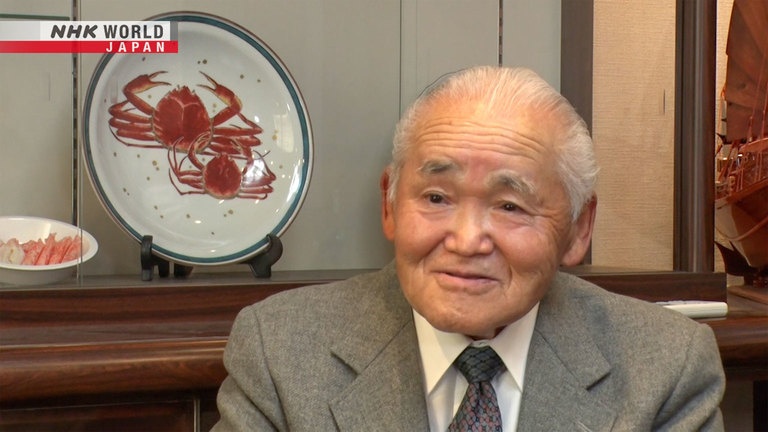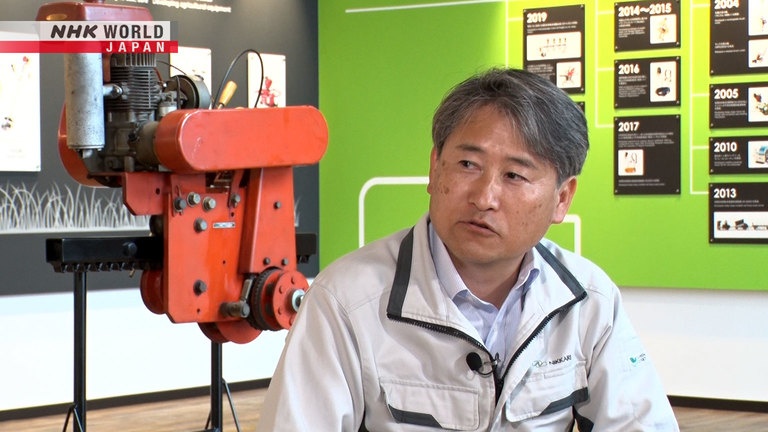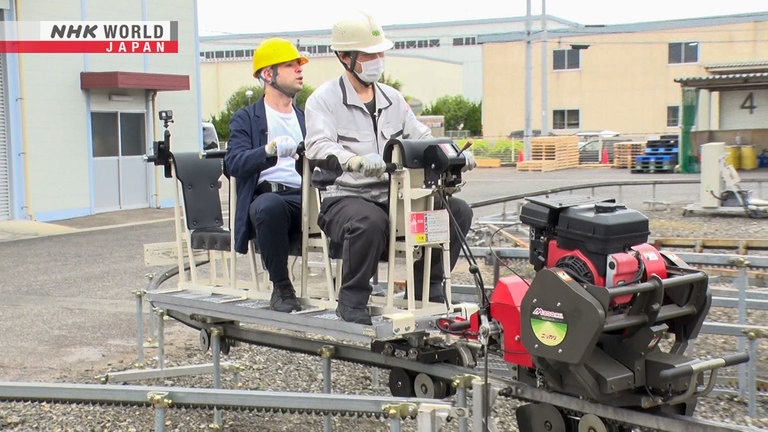Imitation Crab / Monorail Transporters
The fascinating stories and secrets behind hit Japanese products, plus parts and machines that boast the top share of niche markets. In the first half: the story behind imitation crab, invented over 50 years ago and now enjoyed around the world. In the second half: monorail transporters installed on inclines on farmland which help farmers carry their produce.



Transcript
"Japan's Top Inventions"
The behind-the-scenes tales of hit products and creations from Japan.
This is "Japan's Top Inventions."
On today's show...
crab, a favorite dish in Japan.
We tell the story behind a product which tastes like crab
but is made from something totally different.
Later on the show...
It looks like a roller coaster.
This is going pretty high!
Just what is it?
We sent our reporter to find out.
Hello, welcome to "Japan's Top Inventions."
I'm your host, Jason Danielson.
In the first half of our show, we take you "Behind the Creation."
Today's topic is this.
Imitation crab.
This is a top-quality variety available in Japan.
Close attention has been paid so that it looks just like the real thing.
The taste and texture are also similar.
Imitation crab is currently enjoyed
in over 50 countries and regions worldwide.
The product was invented some 50 years ago.
Development was challenging,
but the inventors persevered and succeeded
in creating a beloved new food.
A minced fish product manufacturer in Ishikawa Prefecture.
The company is known for being the first to create imitation crab.
There's the first version.
A photo of their first imitation crab from 1972.
This initial version of the product was shaped like shredded crab meat.
It's been 50 years since then. This is the latest version.
Here it is next to a real crab leg.
At first glance, they appear the same.
The imitation crab is actually the one on the left.
Many people are surprised that it's not actually real crab meat.
Imitation crab is eaten around the world now.
It helped create a new genre of food.
We're very proud of this accomplishment.
Our story begins back in the 1960s.
Chinese restaurants were popular across Japan.
A special ingredient used at these restaurants was jellyfish.
The chewy yet crunchy texture made it a delicacy.
However, the jellyfish came from China.
The Cultural Revolution caused relations with the country
to grow more strained, and jellyfish became hard to get.
Demand began to grow for a substitute product.
A company from Ishikawa Prefecture in the Hokuriku region
saw this as an opportunity.
The company made "kamaboko,"
a type of cured fish cake made from cooking minced fish meat.
The Hokuriku region is abundant with fish and known for kamaboko.
The company had experience creating products
with vibrant colors, good taste and texture.
The man in charge of development was a former company director Seida Minoru.
Here's how he remembers things.
Our company made many specialty kamaboko products.
We thought we could use those techniques to make a substitute for jellyfish.
So, we started experimenting.
Seida got to work right away.
For ingredients, he used egg whites and seaweed.
Would he be able to reproduce the unique texture of jellyfish?
After much testing...
he was able to create something with that chewy yet crunchy texture.
But it wasn't meant to be.
As Seida poured on the requisite soy sauce for seasoning,
his prototype fell apart.
It seems a chemical reaction was taking place.
After adding soy sauce,
it would become like a soft jelly, with no crunch at all.
That wouldn't work as a jellyfish substitute.
Development wasn't going well.
But one day, just as he was about to give up...
Seida was doing another taste-test
with cut pieces of the jellyfish substitute.
He noticed something.
"This texture is a bit like crab meat."
The Hokuriku region, where the company is based, is famous for crab.
It's a celebrated winter delicacy in Japan, enjoyed both cooked and raw.
Surely, there was also demand for a crab meat substitute.
Seida decided to switch the focus to crab.
A new target was in sight.
It wouldn't be enough just to recreate the texture of crab.
How would they make it look and taste like the real thing?
The developers looked towards adding minced fish meat,
a key part of kamaboko.
They would make use of the company's strengths.
First, a seaweed extract was added to the minced fish.
The firmness of the mixture was carefully adjusted with salt.
Red food dye was added for color.
They experimented over and over again with stocks
made from fish and seaweed to simulate the flavor of crab.
We used seaweed stock and fish stock.
Crab has a very rich flavor as you chew on it.
We did our best to recreate that.
Came up with dozens of varieties and recipes.
These are notebooks that Seida used during development.
He experimented again and again
with cooking times, temperatures and other factors.
And finally, in July of 1972.
The shredded variety of imitation crab was completed.
Employees from the company got to work selling the product.
They headed for the largest fish market in Japan, Tsukiji,
where seafood from all over is bought and sold.
They tried to convince the wholesalers and restaurants in the area
that they had something new.
When we brought our imitation crab to restaurants,
the chefs were very surprised.
Thought it was real crab.
It tasted good, had good aroma and color.
And so, in just two months,
the imitation crab grew immensely in popularity.
Production was ramped up, with trucks constantly making deliveries.
Thanks to the imitation crab,
this small company instantly became well-known.
It seemed like it was time to celebrate,
but there were unforeseen challenges to come.
The imitation crab was in high demand.
Other companies caught wind of this and made their own versions.
One company created a new variety in the shape of a stick.
It was an immediate hit.
Within a year, kamaboko manufacturers all over Japan were doing it.
"It's a hit! Let's make our own! Here's how you do it!"
Suddenly, everyone was making it.
Afterwards, certain companies began exporting the product outside of Japan.
Imitation crab came to be found worldwide in salads and sandwiches.
What about the company which created the original?
In July of 2001, the development team was called into the CEO's office.
He had a challenge for them.
"Make an imitation crab that's even better than the real thing."
Present at this meeting was developer, Noda Minoru.
Here's what he remembers.
If the company becomes satisfied with their existing product,
the quality will never improve.
That's why the CEO gave us the order
to make something that was on the same level as real crab.
Noda tackled the challenge right away.
As a point of reference, he chose female snow crab.
Though smaller than males,
the meat of the female crab is rich and succulent.
It's a beloved dish for locals.
Noda procured many of these crabs.
He boiled them, took out the meat,
and placed it in a machine for analysis.
For days, he gathered data
on the texture and flavor compounds of the crab meat.
Even the shape of its fibers.
If you're going to try and surpass real crab,
you first need to scientifically analyze the taste,
flavor, and texture of the meat.
But there are natural variances with real meat.
There are differences in the compounds.
It was difficult getting uniform data.
The results of the study?
The meat of the crab is made up of strands 0.6 millimeters thick.
That was the key to the texture.
But the existing imitation crab meat was 1.2 millimeters thick.
In order to reduce that by half,
they would need to rework the base ingredient.
The minced fish.
Noda repeatedly adjusted factors like the salt content, mixing times,
and temperature of the minced fish
in order to achieve the 0.6 millimeter thickness.
It's extremely difficult as the fibers get thinner.
If the minced fish doesn't hold together, the fibers snap.
We had to change the way we'd been making it
so that it would be strong even when thin.
After all this experimentation,
Noda succeeded in creating fibers with the 0.6 millimeter thickness
on the company's machines.
The next challenge was how to wrap the fibers together.
This is meat from a real crab.
Upon closer inspection,
the fibers are intricately entwined, like the veins of a leaf.
Could this also be reproduced?
Sheets of kamaboko were slit, rolled up, and chopped into sticks.
Would this method work?
The developers kept on adjusting the machine
and conducting taste-tests.
Crab has a distinctive texture.
When you bite into it, it comes apart.
So you can't roll it together too tight.
But if you try to make it loose, it could come apart in the machine.
This was a really tricky part to figure out.
And then there was the vibrant red color of crab.
How could that be reproduced?
The development team looked into all their options.
This is what they settled on.
Tomatoes and red bell peppers.
A blend of these two produced a color similar to real crab.
Finally, in July of 2004,
after three years of development, the new imitation crab was born.
The company decided to target major supermarket chains with their product.
They visited buyers and offered them the new imitation crab.
But the response was muted.
"What makes this new? It's just an extension of your current products."
They said things like, "It's a little sweet," or "A little salty."
That's it. They just saw it as a slight spin on existing products.
How could they make their new product shine?
The team racked their brains for ideas.
They decided to try again, but with a secret weapon.
Sushi, using their new imitation crab as the topping.
It looked just like real crab sushi.
This got the buyer's attention.
I had a business meal once at a sushi restaurant
where they served real crab sushi like this.
I had a flashback to that.
I thought it'd be great to get a sushi chef to prepare our imitation crab,
and try pitching with that.
But the taste test would be the deciding factor.
The team member held his breath.
The buyer was impressed.
"It's delicious. Better than the real thing."
They were amazed. Our product really went well with the rice.
The buyer's reaction was a complete one-eighty.
It even surprised our staff.
Hearing that it was better than the real thing was gratifying.
And so, the buyer recognized the quality of the product.
On the supermarket floor,
the imitation crab wasn't placed with the other kamaboko products,
but with the sashimi and fresh seafood.
Imitation crab which doesn't pale in comparison to the real thing.
How do experts view this invention?
We're joined by Okazaki Emiko to learn more.
Welcome to the show.
Thank you.
What was significant about this imitation crab?
The fact that they used traditional kamaboko techniques
to make something new was significant.
It was such a hit that people say it saved the minced fish product industry.
Kamaboko is a traditional food.
By turning it into imitation crab, consumption shot up tremendously.
That was most significant I think.
Does kamaboko have a long history in Japan?
Japan has a good supply of marine resources.
And the people of Japan used their ingenuity to process
that fish into any products.
Kamaboko, which is mostly made of fish,
is high in protein and low in fat.
It's great for elderly people, athletes who are trying to bulk up,
or young people on a diet.
People from all walks of life can eat these products without prep.
I think of them as an ultimate form of fast food.
What are some of the latest trends in the fish product market?
Products made with minced fish can be shaped and colored in many ways.
Nowadays they can make sausages and hamburgers.
They can even make cheesecake, donuts, and other sweets.
The industry is looking for their next hit after imitation crab.
I'm looking forward to what they come up with next.
Thank you for your time. It was nice speaking with you.
The pleasure was mine.
Top Niche Creations.
Our next segment is "Top Niche Creations."
Today we're looking at this machine,
which was developed for agricultural use.
It's equipped with a small engine and travels on a single rail.
A compact monorail.
These devices can now be found in some ten countries and regions worldwide,
including Italy and France.
Just what is it used for?
We sent our reporter to find out.
Hey everyone. This is Cyrus Nozomu Sethna.
Today I am in the western Japanese prefecture of Okayama.
The machine in question is being made by this company right over here.
So, let's take a look.
We're at an agricultural machinery manufacturer.
Hello there, Mr. Sugimoto.
Hello.
Our guide is the president of the company, Sugimoto Hiroshi.
The company employs about 130 people.
Their products are used around the world.
Inside the building, the company's first model from 1966 is on display.
This is the first version of our main product.
Very interesting. Could you tell me a bit about how it works?
It's powered by an engine.
The black part here is the rail.
It rides wherever rail has been laid down.
What does it look like in motion?
We were shown to the backyard of the complex.
Oh wow. Look at that.
This is the test track for our monorail.
Amazing. Suddenly, it's like we're at a theme park.
We're going to get a demo of a model with passenger seating.
Who's riding? Yours truly.
- OK, are you ready?
- You bet.
Let's go.
Okay, we're moving. How fast does this thing go?
About 40 meters per minute.
I see, so not that fast.
That's right.
The machine moves at about walking speed.
But soon, we reach a sharp incline.
Oh my!
Whoa! This is going pretty high.
Look at it climb.
It's a steep slope with a 47-degree incline,
but the machine climbs up without slowing down.
Wow.
So, where exactly are these machines used?
In mandarin orange groves or other fruit farms on sloped terrain.
It's invaluable at such locations.
Here is actual footage of the machine in action.
This citrus grove on hilly terrain has one of these monorail transporters.
The track only requires about a meter-wide space for installation.
This allows it to be easily adapted to various landscapes.
With a machine like this doing the heavy lifting,
there is no need for manual labor.
This company holds the largest market share for monorail transporters.
They were founded in 1959.
They originally made and sold mowers.
In the 60s, the troubles of mandarin orange farmers
led to the development of their transporters.
Many mandarin orange farms are located on slopes.
The harvest was brought down by hand.
It was a great burden, and we wanted to do something to help.
Development required many trips to mandarin farms for testing,
and hundreds of hours of trials.
In 1966, the company's first monorail transporter was completed.
The key to the design?
It looks like there are teeth meshing here.
This part is what's referred to as the rack.
It's attached to the underside of the rail
and is gripped by the machine's wheels.
The company has a patent for this design in Japan.
The wheels on the machine mesh with the rack.
This allows the machine to move steadily even on a slope.
It goes up even while pulling a heavy load.
The design also prevents slipping.
No slipping. That's important.
Yes.
The monorail transporters came to be used at many farms in Japan
growing fruit like mandarins, plums, and peaches.
Later, the machines came to be used in Germany and Italy at vineyards,
addressing a common concern.
Around 75,000 machines have been shipped,
helping to relieve farmers around the world from a heavy burden.
At the end of our visit,
the president shared the company's next area of focus.
Construction and engineering.
You need something like this for construction on mountains,
where you can't bring heavy machinery up.
Or materials.
Maybe you're making a communications tower or a transmission tower.
You can carry materials for those with this too.
They're useful in a lot of situations aren't they.
Yes. Like places where cars can't get to.
They can be used in all kinds of places.
It's time for a pop quiz.
These monorail transporters help move heavy objects across sloped terrain.
Certain models are used in construction.
What's the maximum load that they can handle?
Choose from one of these three options.
(500kg 1t 3t)
The answer is...
three tons!
These heavy-duty models come equipped with large engines.
They can even transport heavy machinery like excavators or cranes.
Just what will these machines be carrying next?
That's all for this episode of "Japan's Top Inventions."
We'll leave you with more about the developer of the imitation crab
from the first half of the show.
See you next time! And stay inventive.
(Seida Minoru developed the imitation crab in 1972.)
(He's 85 now, and still has the notebooks he used during development.)
(He colored this sketch of imitation crab in a shade of bright red.)
(Even after 50 years, it remains vibrant.)
Imitation crab was born from a real pioneer mindset.
I'm proud of it.
The key was passion. And to look at things objectively.
This whole ride has been a truly amazing experience.
I'm really thankful.